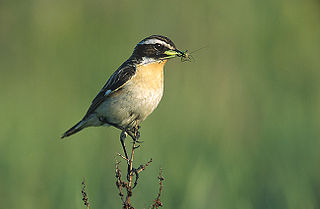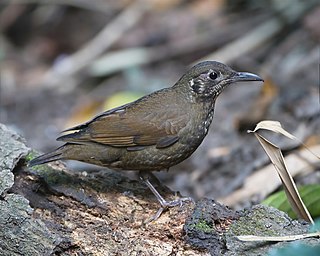
Chats are a group of small Old World insectivorous birds formerly classified as members of the thrush family (Turdidae), but following genetic DNA analysis, are now considered to belong to the Old World flycatcher family (Muscicapidae).

The scaly thrush is a member of the thrush family Turdidae.

The palm thrushes are medium-sized insectivorous birds in the genus Cichladusa. They were formerly in the thrush family Turdidae, but are now treated as part of the Old World flycatcher Muscicapidae.

The Eurasian curlew or common curlew is a wader in the large family Scolopacidae. It is one of the most widespread of the curlews, breeding across temperate Europe and Asia. In Europe, this species is often referred to just as the "curlew", and in Scotland known as the "whaup" in Scots.

The blue rock thrush is a species of chat. This thrush-like Old World flycatcher was formerly placed in the family Turdidae. It breeds in southern Europe, northwest Africa, and from Central Asia to northern China and Malaysia. The blue rock thrush is the official national bird of Malta and was shown on the Lm 1 coins that were part of the country's former currency.

The white-necked thrush is a songbird found in forest and woodland in South America. The taxonomy is potentially confusing, and it sometimes includes the members of the T. assimilis group as subspecies, in which case the "combined species" is referred to as the white-throated thrush. On the contrary, it may be split into two species, the rufous-flanked thrush and the grey-flanked thrush.

The austral thrush is a medium-sized thrush from southern South America. There are two subspecies, the Magellan thrush from south Argentina and south and central Chile, and the Falkland thrush from the Falkland Islands.

The Sulawesi thrush is a species of passerine bird in the thrush family, Turdidae. It is endemic to the island of Sulawesi in Indonesia, where it inhabits evergreen montane forests at altitudes of 1,100–2,400 m (3,600–7,900 ft). Although it has a limited range and is not a common bird, the IUCN has assessed it as being a "least-concern species".

The rufous-tailed palm thrush is a species of bird in the family Muscicapidae.

The Amber Mountain rock thrush is a songbird in the family Muscicapidae, formerly placed in the Turdidae together with the other chats. It is now usually considered a subspecies of the forest rock thrush.

The Malayan whistling thrush or Malaysian whistling-thrush is a species of bird in the family Muscicapidae. It is endemic to the Malay Peninsula. Due primarily to habitat loss, its population is thought to be in decline.

The white-throated thrush is a species of bird in the family Turdidae. It is found in Mexico and Central America, ranging south to central Panama. This species has been referred to in some literature as "white-throated robin." However, that name is now more usually applied to the Old World species Irania gutturalis.

The Japanese thrush is a species of bird in the thrush family Turdidae. The species is also known as the grey thrush or the Japanese grey thrush. The species was once split into two subspecies, with birds breeding in China being treated as the subspecies T. c. lateus,, but today differences are attributed to natural variation and the species is treated as being monotypic.

The Kurrichane thrush is a species of bird in the thrush family Turdidae. The species is found from central through to southern Africa. Its natural habitat is dry savanna and woodland, predominantly miombo woodland.

The dark-sided thrush is a species of bird in the thrush family Turdidae. It is also known as the lesser brown thrush, the long-billed ground-thrush, and the dark-sided ground-thrush. The species is monotypic and is closely related to a number of thrushes in the genus Zoothera, including the long-billed thrush and the widespread scaly thrush. It was described by Edward Blyth in 1847 based upon a specimen collected in Rakhine in Burma (Myanmar).

The Aztec thrush is a species of bird in the family Turdidae. It is found mainly in Mexico, but vagrants are occasionally seen in the United States. Its natural habitat is montane forests. The IUCN Red List denotes it as a least-concern species.

The brown-winged whistling thrush, also known as the Sumatran whistling thrush or chestnut-winged whistling thrush, is a passerine bird belonging to the whistling thrush genus Myophonus in the family Muscicapidae. It is endemic to the island of Sumatra in Indonesia. In the past, it has often been lumped together with the Javan whistling thrush and Bornean whistling thrush as the "Sunda whistling thrush" but it is now often regarded as a separate species based on differences in plumage and measurements.

The rufous-collared thrush is a species of bird in the family Turdidae.

The Abyssinian thrush is a passerine bird in the family Turdidae. It is also known as the African mountain thrush, northern olive thrush or Ethiopian thrush. In 2010, the species was confirmed as separate from the olive thrush due to genetic differences. Their ranges do not overlap. The southern and northern populations may be distinct species. The Abyssinian thrush is found in Eritrea and other parts of the Horn of Africa, as well as an area to the southeast extending from the African Great Lakes region to north eastern Zambia and Malawi.

Western quail-thrush is a species of bird in the family Psophodidae. It is found in arid inland habitat in the western regions of Australia. It remains along the west side or coast of Australia. They typically reside in dry woodland shrub with low understory on a stony ground. The weather they are most commonly found in is semi-arid or arid air.





















